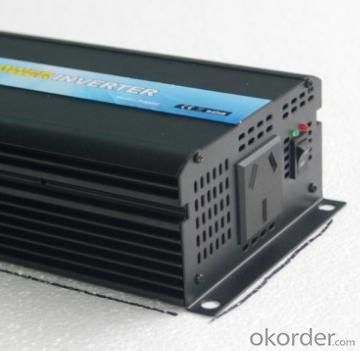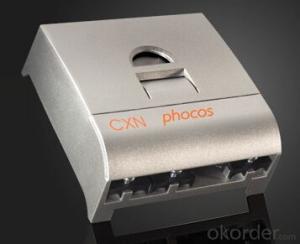Solar CXN Series (10 – 40 A) Programmable Solar Charge Controller with Negative Grounding
- Loading Port:
- China Main Port
- Payment Terms:
- TT or LC
- Min Order Qty:
- -
- Supply Capability:
- 10000 unit/month
OKorder Service Pledge
OKorder Financial Service
You Might Also Like
1, Product desciption
The DC power for the inverter section can be derived from a normal AC wall outlet or some other source. Control and feedback circuitry is used to adjust the final output of the inverter section which will ultimately determine the speed of the motor operating under its mechanical load.
Motor speed control needs are numerous and include things like: industrial motor driven equipment, electric vehicles, rail transport systems, and power tools. (See related: variable-frequency drive ) Switching states are developed for positive, negative and zero voltages as per the patterns given in the switching Table.
The generated gate pulses are given to each switch in accordance with the developed pattern and thus the output is obtained.
2, Features of the product
Inverters convert low frequency main AC power to higher frequency for use in induction heating.
To do this, AC power is first rectified to provide DC power. The inverter then changes the DC power to high frequency AC power. Due to the reduction in the number of DC Sources employed, the structure becomes more reliable and the output voltage has higher resolution due to an increase in the number of steps so that the reference sinusoidal voltage can be better achieved.
This configuration has recently become very popular in AC power supply and adjustable speed drive applications. This new inverter can avoid extra clamping diodes or voltage balancing capacitors. There are three kinds of level shifted modulation techniques, namely
Is the electrical grid already nearby or would you need to call in the power company to bring in electrical lines.
If the electric needs to be brought to the area, how much is this going to cost? Depending on how far the grid electric is from the location of the needed lighting, this can be quite expensive.
How much lighting is needed on the street? Do the lights need to be dark sky compliant.
Do the street lights need to run from dusk to dawn or for only a specified number of hours at night.
Are the street lights able to dim in the middle of the night and still provide enough lighting.
These questions need to be answered before you can decide on how many lights you will need to complete the project.
3, Product Image

4, Detailed Specification
INPUT | |
Input voltage range | 185~265±5Vac |
OUTPUT | |
Output voltage range | 185~265±5Vac (AC mode) , 230Vac (DC mode) |
Output frequency (DC mode) | 50Hz (48~54Hz) or 60Hz(58~64Hz), same as AC(AC mode) 50Hz ±0.3Hz (DC mode) |
Wave form | Sine wave (DC Mode) |
Transfer time | 10ms. (Typical) |
BATTERY | |
Rated charging current (max.) | 45A |
Norminal DC input voltage | 12V |
Min. DC start voltage | 20V / 40V |
PHYSICAL | |
Unit dimension (mm) | 526*277*212 |
Master box dimension (mm) | 620*350*370 |
Net weight (1pc, kg) | 22.8 |
- Q:How does a solar controller prevent battery discharge during nighttime?
- A solar controller prevents battery discharge during nighttime by automatically detecting when there is no solar energy being generated and disconnecting the battery from the solar panel. This prevents any power from being drained from the battery and ensures its stored energy is preserved for use during the night.
- Q:How does a solar controller handle battery short circuit protection?
- A solar controller handles battery short circuit protection by constantly monitoring the current flow between the battery and the solar panels. If a short circuit occurs, the controller immediately detects the sudden increase in current and activates a protection mechanism. This can involve cutting off the current flow from the panels to the battery, preventing any damage or overheating that could occur.
- Q:What is the maximum distance between the solar panel and the solar controller?
- The maximum distance between the solar panel and the solar controller depends on various factors such as the type of wiring used, the voltage drop over the distance, and the specific requirements of the solar panel and controller being used. Generally, it is recommended to keep the distance between the panel and controller as short as possible to minimize voltage drop and ensure efficient energy transfer. However, in most cases, a maximum distance of around 100 feet (30 meters) is considered acceptable for low-voltage solar systems. It is always best to consult the manufacturer's guidelines or seek professional advice to determine the maximum distance suitable for your specific setup.
- Q:Can a solar controller be used in a solar-powered cruise ship?
- Yes, a solar controller can be used in a solar-powered cruise ship. A solar controller is an essential component in solar power systems as it regulates the charging and discharging of batteries, ensuring the efficient and safe operation of the system. In a solar-powered cruise ship, the solar controller would be used to manage the energy flow from the solar panels to the batteries, ensuring optimal power generation and storage.
- Q:Can a solar controller be used with a generator backup system?
- Yes, a solar controller can be used with a generator backup system. The solar controller helps regulate the charging of batteries from solar panels, while the generator backup system provides alternative power during periods of low sunlight or high demand. The two systems can work together to ensure a reliable and efficient power supply.
- Q:Can a solar controller be used with a solar-powered university or college?
- Yes, a solar controller can be used with a solar-powered university or college. A solar controller is an essential component of a solar power system that regulates the voltage and current flow from the solar panels to the battery. It ensures the efficient and safe charging of the batteries, which are used to store the solar energy generated. Therefore, a solar controller is necessary to effectively manage and utilize the solar power in a university or college setting.
- Q:How do I integrate a solar controller with my existing solar system?
- To integrate a solar controller with your existing solar system, you will need to follow these steps: 1. Determine the compatibility: Check if the solar controller you have is compatible with your existing solar panels and inverter. Look for specifications such as voltage and current ratings to ensure a proper match. 2. Disconnect power: Before making any connections, make sure to disconnect the power supply to your solar system to avoid any accidents. 3. Locate the existing system components: Identify the location of your solar panels, inverter, battery bank (if applicable), and any existing charge controller. This will help you plan the integration process effectively. 4. Mount the solar controller: Choose an appropriate location to mount the solar controller near your existing system components. Ensure it is easily accessible and well-ventilated. 5. Connect the solar controller: Connect the solar panel wires to the solar controller's input terminals, following the manufacturer's instructions. Ensure proper polarity and tight connections. If you have multiple solar panels, they may need to be wired in series or parallel configurations, depending on the solar controller requirements. 6. Connect the output: Connect the solar controller's output terminals to the input terminals of your existing charge controller or inverter. Again, follow the manufacturer's guidelines for proper wiring and polarity. 7. Reconnect power: Once all connections are made, reconnect the power supply to your solar system. 8. Configure the solar controller: Depending on the model, you may need to configure the solar controller settings for optimal performance. Consult the user manual for specific instructions. 9. Monitor and test: Monitor your solar system's performance after integrating the solar controller. Ensure that the controller is functioning correctly and that your system is operating efficiently. If you are unsure about any step or lack experience with electrical installations, it is recommended to consult a professional electrician or solar installer for assistance to ensure a safe and successful integration process.
- Q:Can a solar controller handle power surges from the utility grid?
- No, a solar controller typically cannot handle power surges from the utility grid. Its primary function is to regulate and control the flow of electricity from the solar panels to the battery bank. Power surges from the utility grid are usually handled by surge protectors or other equipment specifically designed for that purpose.
- Q:Can a solar controller be used with solar-powered indoor parking facilities?
- Yes, a solar controller can be used with solar-powered indoor parking facilities. Solar controllers are designed to regulate the flow of electricity between the solar panels and the batteries, ensuring optimal charging and preventing overcharging. In solar-powered indoor parking facilities, the solar controller would play a crucial role in managing the energy generated by the solar panels and efficiently storing it in the batteries for later use.
- Q:Can a solar controller be used in a solar-powered space exploration mission?
- Yes, a solar controller can be used in a solar-powered space exploration mission. A solar controller is designed to regulate the charging and discharging of batteries in a solar power system, ensuring optimal performance and preventing damage. In a space mission, where power is derived from solar panels, a solar controller would be essential for efficiently managing and controlling the flow of electricity to the spacecraft's batteries, enabling uninterrupted power supply and maximizing energy utilization.
1. Manufacturer Overview |
|
|---|---|
| Location | |
| Year Established | |
| Annual Output Value | |
| Main Markets | |
| Company Certifications | |
2. Manufacturer Certificates |
|
|---|---|
| a) Certification Name | |
| Range | |
| Reference | |
| Validity Period | |
3. Manufacturer Capability |
|
|---|---|
| a)Trade Capacity | |
| Nearest Port | |
| Export Percentage | |
| No.of Employees in Trade Department | |
| Language Spoken: | |
| b)Factory Information | |
| Factory Size: | |
| No. of Production Lines | |
| Contract Manufacturing | |
| Product Price Range | |
Send your message to us
Solar CXN Series (10 – 40 A) Programmable Solar Charge Controller with Negative Grounding
- Loading Port:
- China Main Port
- Payment Terms:
- TT or LC
- Min Order Qty:
- -
- Supply Capability:
- 10000 unit/month
OKorder Service Pledge
OKorder Financial Service
Similar products
New products
Hot products
Hot Searches
Related keywords






























